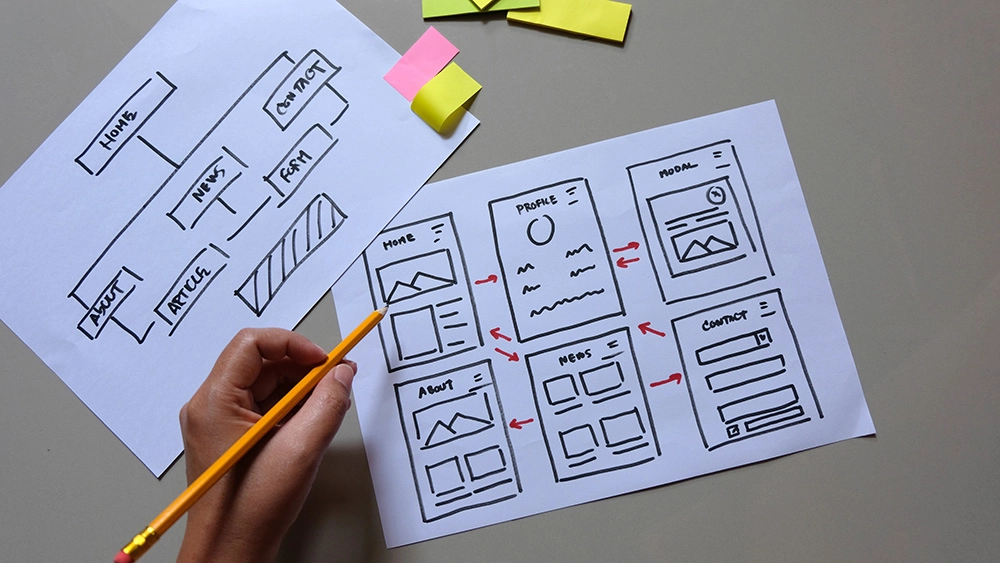How would you describe your ideal website? Is it clean, functional, or something else entirely? If you don’t know exactly what you want, then you might miss out on some great opportunities.
A well-designed website can increase conversions, improve user experience, and even boost sales.
To create a successful website, you will need to consider several things, such as usability, functionality, aesthetics, and SEO (search engine optimisation). The 7 steps below will guide you through the entire process.
- Planning
- Wireframing
- Design Process
- Development
- Testing
- Launch
- Maintenance
1) Planning your website

When you are planning your website, there are a few key things to keep in mind. First, you need to decide what kind of website you want.
Websites fall into three main types: informational, transactional, and hybrid.
- Informational websites are typically used to provide information about a company or product.
- Transactional websites allow users to buy products or services online.
- Hybrid websites combine both informational and transactional elements.
Once you have decided on the type of website you want, you need to choose a domain name. This is the address people will use to access your site. Try to choose something short and easy to remember.
Finally, you need to decide who will design and build your website. If you are not sure where to start, we can help. Building a website is like any other project – if you do not take the time to plan it out, you will probably end up with something that does not meet your needs.
So how do you go about planning your website?
- Define your goals. What do you want your website to achieve? Are you looking to sell products online, or simply provide information about your business? Knowing what you want to accomplish will help you decide about everything from the design of your site to the functionality it needs.
If you are a painter and decorator, your goal might be to generate more local business via your website. If you run a small bakery, your goal may be to create an online shop so local people can have bread delivered to their door in order to expand your market reach.
- Know your target audience. Who are you building your website for? What kind of information do those people need?
Knowing your target audience requires research. During the planning stage of a website build, it is vital to carry out keyword research to learn the words and phrases that your potential customers are looking for.
All the above can be a time sink, especially if you already have your hands full running a business. A professional website design agency can help you with the keyword research that is necessary before moving on to the design process.
2) Wireframing

Wireframing is an important step in the web design process because it helps you to plan the hierarchy of your content, and decide how users will navigate through your site.
There are a few things to keep in mind when wireframing your website. First, think about what type of content you want to include within it. This will help you determine the hierarchy of your pages and the layout of your content. Second, consider how users will navigate through your website. This will help you create a user-friendly navigation system. Finally, think about what features you want to include on your website and how you will implement them.
Creating a wireframe for your website is relatively simple. You can use pen and paper, or there are various software programs that allow you to create digital wireframes.
Once you have created your wireframe, you can start adding visual elements like colours and images. Remember, the purpose of a wireframe is to help you plan the structure of your site, not to design it.
By following these tips, you can create a well-organised and effective wireframe for your website.
3) Design Process

The design of your website should reflect everything your potential clients feel about your business. You need to think about your brand identity, the colours, the fonts, the spacing and overall look. You want your clients to remember you.
Keep in mind that first impressions are everything. Make sure that your website makes a good impression on those who visit it, or you may lose potential customers or clients.
Designing a website becomes much easier once you have planned and wireframed it. You cannot go straight into design without understanding your customers and creating a basic skeleton (wireframe) for your website.
Our design team usually creates the aesthetics of a website using software from Adobe and we will share the concepts with you using platforms like Figma or Adobe XD. At this stage, the design may well be taking shape but it is not finalised – we are still testing the impact of our colour pallet, fonts, spacing and all the elements that will eventually make up our website.
Through collaboration with you – actioning your feedback and implementing our own suggestions – we will reach the stage where the design is agreed upon and the actual build of the website can begin.
4) Development

In the development phase, we move our design to code. We take the layouts, images and fonts that have been agreed upon and turn them into a fully-functioning, fast-to-load, totally responsive website. It is important to note that Google takes website speed seriously, and that website speed is affected by having too many bells and whistles on a site.
Often, it is worth considering whether the extra whizzy bits on a website offer real value and even whether they serve a purpose, and then removing the ones that do not bring a tangible benefit (but simply slow the site down). With the content stripped back to what is important, your end users will have a better experience on your website and, as it will be faster to load than before, Google will give it more prominence in search results.
5) Testing

There are several important factors to consider when testing a website. Website visitors expect a certain level of functionality and usability from a site, so it is important to make sure that all aspects of the site are functioning properly before launch.
One of the most important aspects of website testing is cross-browser compatibility. Different browsers interpret code differently, so it is important to test how the site looks and functions in different browsers. Another key factor is load time; visitors will not wait around for a slow-loading site. Testing can help identify any areas where the site needs improvement before launch.
Thorough testing is essential in launching a successful website. By taking the time to test all aspects of the site, you can be confident of giving visitors a positive user experience.
It may not be feasible to test your website on every combination of device and operating system. This is a where statistics come in. If you can, you should find the top 10 devices and operating systems used to view your website, and optimise specifically for them. That should cover 99% of your end users and mean that testing can be completed in a sensible time frame, for a reasonable budget.
At BBI, we use a range of devices and simulated devices which we can access remotely in different regions across the globe. This ensures that we can detect and subsequently fix any cross-browser issue that might arise in a website build project. If you have a cross browser issue you cannot fix, get in touch!
6) Launch

You have been working hard for months, writing content, perfecting the design, and making sure everything is just right. And now it’s finally time to show the world what you have been working on… it is time to launch!
You are probably feeling a mix of excitement and nerves right now. That’s normal! Launching a website is a big deal. But do not worry, you are ready for this. You have put in the hard work and now it is time to reap the rewards.
Your website is going to be amazing! It’s going to be a great resource for your readers and a place where you can really showcase your talents. So hit that launch button – your website is ready for the world!
But wait! Have you gone through your launch list?
- Have you tested your site thoroughly? Check for broken links, misspellings, and other errors.
- Have you optimised your site for search engines? Use keywords throughout your site content and in your meta tags.
- Have you set up Google Analytics? This will help you track visitors to your site and measure your success.
- Have you created a sitemap? This will help search engines index your pages correctly.
- Have you submitted your sitemap to search engines? This step is critical for making sure they included your pages in the search results.
- Have you created a favicon for your site?
The above is the bare minimum. Depending on the content management system you use, the list may be different.
If you are worried that you may have missed something, the website launch checklist over at Hubspot offers some great advice (in amongst some woolly catch-all suggestions).
7) Website Maintenance

Website maintenance involves a series of tasks which are completed on a daily, weekly or monthly basis, which ensure that a website runs smoothly.
It is important to keep your website maintained. The most obvious reason for this is to keep website hackers out of your website.
As well as the prevention of nasties, you need to keep on top of your website’s performance.
Below is a list of tasks in no particular order which you can add to any maintenance plan.
- Make sure images are optimised
- Make sure scripts are optimised
- Check for broken links
- Update plugins
- Test backups
- Run security checks
- Cross browser check (sometimes new devices come out which need to be tested)
- Check for typos
- Check forms are still working – it would surprise you how many forms magically break!
If you are a small business owner, it is better that you pay a professional for website maintenance, as it can take many hours out of your week. Talk to us!
Conclusion
Your website is your digital storefront. First impressions matter, so make sure you design your site in a way that is visually appealing and easy to navigate. Use engaging content and calls to action to encourage your visitors to take the next step. By following these tips, you can create a website that will help you achieve your business goals.